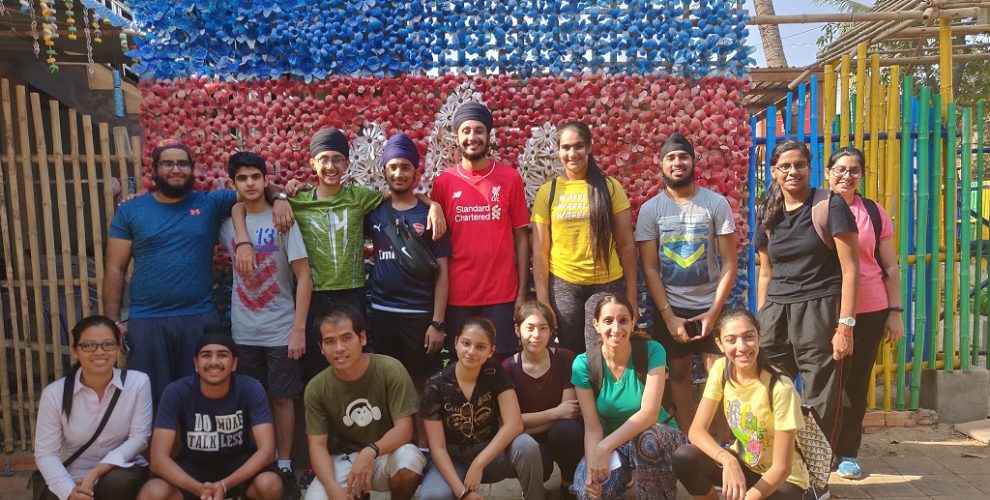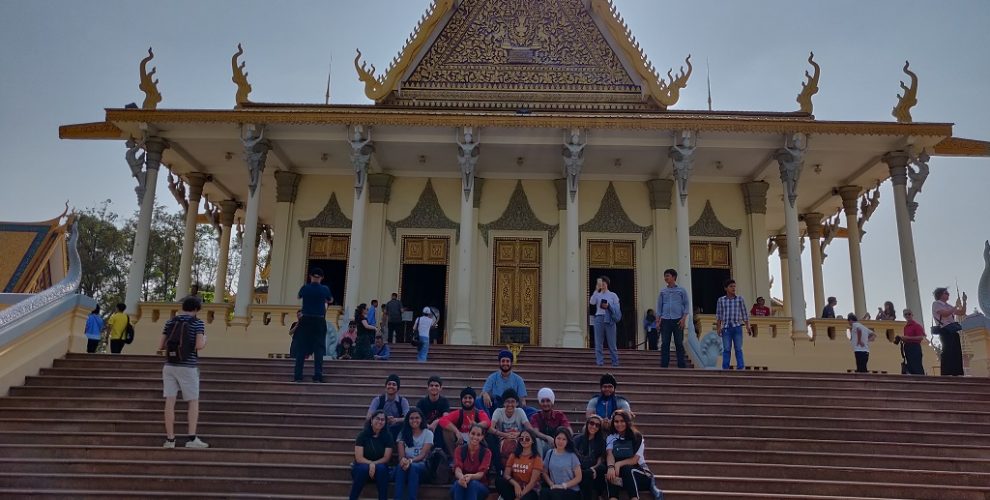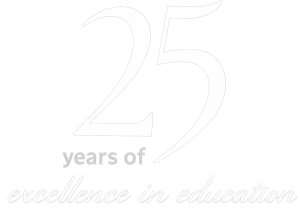On February 27th 2019 a group of 13 students accompanied by teacher advisor, Ms Harpreet, left to Cambodia for an outreach program under the umbrella of the Youth Ambassadors Singapore. We departed from KLIA at 12.45 pm and arrived at Cambodia at about 2.30 pm in the afternoon. It was a 4 days and 3 nights stay starting on Wednesday and ending on Saturday. The aim of this program was to create an awareness amongst us as to life in Cambodian schools and specifically the set up of the Coconut School. Our main project work was to help build a wall for the Coconut School.
Cambodia is a land full of culture. The capital city is Phnom Penh. The main language spoken there is Khmer. Most Cambodians practice Buddhism. Cambodia is best known for their truly beautiful pagodas all over the country. Food in Cambodia is similar to Thai or Vietnamese food except for the fact that Cambodian dishes do not contain much spice. Fun fact: Cambodia has 3 different flags which represents their religion, king and nation. One of Cambodia’s most beautiful attractions is the Mekong River. It flows through China, Burma, Thailand, Laos, Cambodia and Vietnam.
On the first day, we went to visit the Royal Palace. Gleaming in gold, the Royal Palace is one of Phnom Penh’s most splendid architectural achievements. It is home to His Majesty Preah Bat Smdech Preah Norodom Sihanouk. The palace was built in 1866. The Royal Palace consists of some spectacular buildings. One of them being the Silver Pagoda. The floor is covered with five tonnes of silver spread across more than 5,000 tiles. The staircase leading to the pagoda is made of Italian marble, with the temple home to a life-sized gold Buddha which consist of 2,086 diamonds.

We then headed to the bustling Central Market. The central market is huge and filled with everything you can imagine from clothes to jewelry. A few of us worked our magic to bargain and get cheaper prices for some beautiful items. We ended our visit with 14 refreshing cups of ice-cold coconut water ( 3 were free !) and headed back to the High Sky Hotel to rest well for the even more exciting day to come.
On day 2, we were up by 6am and ready to leave by 8am. We took two minivans to reach the Coconut School. When we arrived, we met Mr. Sin Song Heng who was the principal of the Coconut School. He first brought us to the old site of the Coconut School. He showed us around the old compound and we were amazed to see that most of the walls were made of recycled items such as glass bottles and tyres. After that, Mr Heng took us to the new site. He explained that it was too expensive to get the land by the road – we had to walk through a narrow 130m pathway to reach the school’s new location. It was still undergoing construction. Then, we started off with our project.
Our first task was to carry 2000 bricks along the 130m pathway to the school site. We were given only 3 wheelbarrows so everyone carried about 6 bricks back and forth. We took approximately 3 hours and then headed for lunch. After lunch, we proceeded to mix the cement. We were told to mix 2 wheelbarrows of sand with one bag of cement. Mr Heng came to the rescue teaching us how to mix the cement and soon we were able to do it. Once the cement was mixed, we started laying the bricks. We had to put one layer of cement at the bottom and to the sides of the bricks and lay them in a straight line. The hardest part was to ensure the bricks were in a straight line! We managed to complete this in 3 hours and Mr Heng jokingly named our wall the ‘snake wall’ as it was not very straight. He thanked us for our hard work and effort. It was now time to go for dinner and head back to the hotel for a much-needed rest.
We awoke bright and early on the third day ready for another day of excitement. In the morning, we went back to the Coconut School to complete our wall. After that, we headed to the silk farm, which was located by the Mekong River for lunch. It was a beautiful compound filled with greenery. The locals showed us the process of getting silk. First, they boiled the cocoons of the silkworms to extract the silk. The first layer is the raw silk which is in pale-yellow colour and the layer inside is the smoother silk which is silverish white in colour. Then they dye the silk to get the colours they need. The dyed silk is put on a spinning wheel ready to be weaved into cloth. A few of us were given the chance to learn how to weave a simple checkered pattern into a silk scarf. The locals used a wooden weaving machine to weave silk. There were two pedals and a board and we had to alternate between both pedals putting the silk through a wooden space and then pull the wooden board forward to make the pattern. It was a great experience.
Later, all of us departed to the Ronas Primary School. At the school we taught them how to play the games that we brought, thanks to the donation drive at SDIS. These included; basketball, jombola, skipping ropes, beanbag, card games and Malaysian traditional games like Congkak and Batu Seremban. I can speak for all of us when I say the students brought huge smiles to our faces and we to theirs , filled us with so much joy and excitement. It was truly an experience we will cherish in our hearts. We returned to the Coconut School where we had a meeting session with Mr Heng who moved us with his inspirational message.
Mr Heng’s mission was not only to educate kids about subjects. Teaching them about life and being good people was what mattered most. In his opinion, using knowledge to help people is the best thing one can do. He told us of many life changing experiences that he went through which made him the person he is today. Mr Heng was a doctor but gave up his profession as he saw many adults and children coming into the hospital at stages where it was too late to help them. They were not exposed nor educated in ways to get themselves treated as they could not afford an education. In the words of Mr Heng “Educated people with bad intentions can destroy the whole world. At the Coconut School we teach and show the children the good in their hearts.”
Overall, this was a truly inspirational program and we are fortunate to have had this amazing experience.. Seeing how Cambodian students live, has changed my paradigm and made me grateful for all I have. This experience is one I will never forget.
Prepared by,
Gureesha Kaur
YR 10



